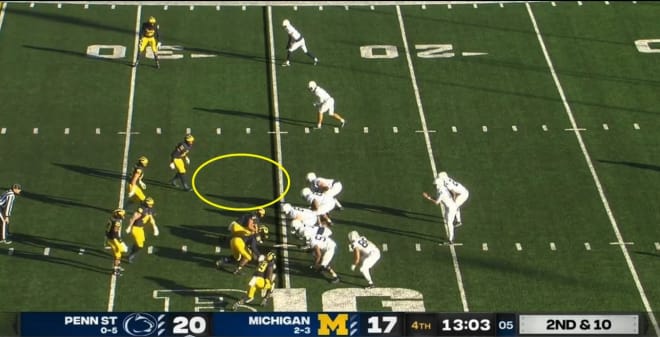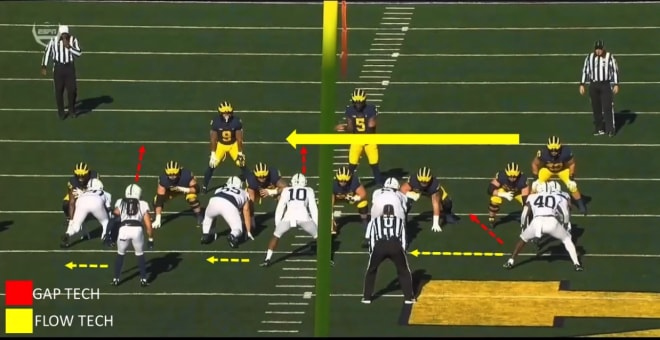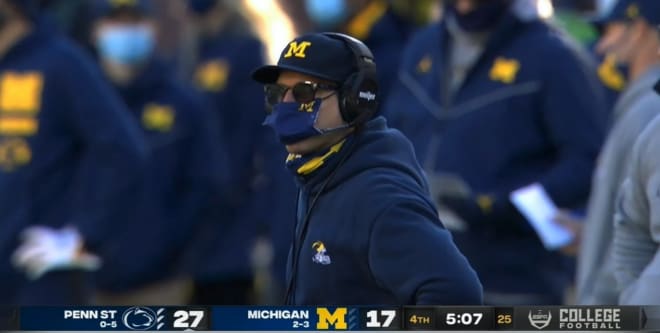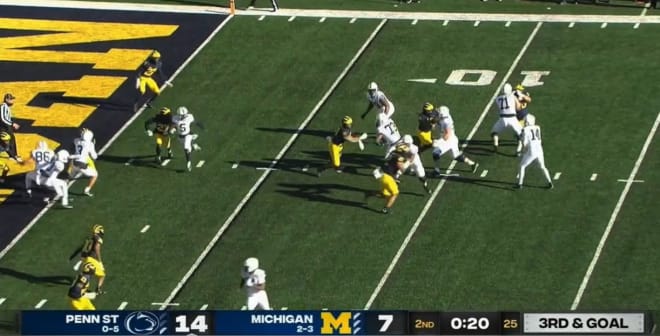Michigan Film Study: Feel flows
The Penn State football team finally broke through and got its first win of the season Saturday afternoon at Michigan.
While the Nittany Lions' fundamental problems did not vanish, they were able to find a way to overcome them through coaching, better play, and a bit of luck in order to beat the Wolverines in Ann Arbor for the first time since 2009.
Today, we’ll take a look at what offensive coordinator Kirk Ciarrocca did in order to help his struggling quarterback, how the offense found it’s flow, and how the defense was able to finally get stops.
(Optional musical accompaniment to today's analysis.)
Flow
Thanks to quarterback Sean Clifford's "flow state," Penn State's offense found a rhythm like it had not found all season. The ball came out of the quarterback’s hands on time and on target to receivers in a crisp and efficient way.
So, what changed in Clifford this week?
Through the first five weeks, he had been a turnover machine who was unsure of what he was seeing. He didn't look confident or comfortable in the pocket, so Ciarrocca helped out by lightening the load.
Simply put, he took most of the decisions out of Clifford's hands Saturday. For example, he attempted 28 passes against Michigan, eight of which were slant routes, with another four being bubble screens.
It also helped that Penn State’s wide receivers were able to reliably get separation and present good targets for Clifford. There were some tight-window throws, but for the most part, things were clean for the redshirt junior to read and deliver the ball. Even if there had been a second- or third-read in his progression Saturday, Clifford didn’t get to it very often.
For a player who is admittedly having a hard time finding his flow, forcing Clifford into that state required an adjustment by the offensive coordinator, giving him throws from which he could succeed. This was something that head coach James Franklin hinted at earlier in the week.
“He’s a vet," Franklin said of Ciarrocca. "He’s working his tail off to get it fixed and to make it better... Kirk’s a pro and a vet, he’s been doing this a long time."
While the foundation of Ciarrocca’s offense is based in simplicity and efficiency in the passing game, he does have more complex, NFL-style plays in the playbook that the team has used this year. Consider some of the more difficult or long-developing plays that Clifford has attempted to run this year.
It’s not surprising that PFF, which tracks a quarterback’s average time to throw on every play, had Clifford with an average time to throw of 2.37 seconds on Saturday. His average for the season had been 3.07, which is a massive swing.
Even the more aggressive deep passes that Clifford attempted were relatively simple go-balls, although none of them were very good.
So for the most part, Ciarrocca worked this week to take the quarterback out of the equation.
That’s not to say Clifford wasn’t a key player in the Nittany Lions’ win on Saturday. Every offense needs a trigger man to throw accurate passes to his playmakers. If there’s one thing, Clifford is that. He can deliver the ball accurately and on time when he has a clear flow.
Two things made this possible. One was that they were able to score early and didn't trail at any point in the game. You can’t operate a short, quick passing attack if your team is down by multiple scores.
The other is…
Explosive Plays
There are two ways in which you can create explosive plays. One is by scheme where a player is either wide open on a passing route, or on a rushing play that was so successful no player has a shot at a tackle.
The other is to make more out of the play than is there.
As always, it’s a little bit of both. Penn State does have good players who are capable of making plays any given week. It does help though when your opponent is doing things like this.

It makes it easier to run the ball when there is no left side of the defensive line within three yards of the line of scrimmage.
To the point of broken tackles though, there's a staggering difference between week six against the Wolverines and the rest of the season. Penn State forced a total of 15 missed tackles in the running game and after the catch this week.
The Nittany Lions had 36 in the previous five weeks combined.
It’s almost like a weight was lifted off of the Penn State offense Saturday, and there was finally room to run. They gained 247 of their 417 total yards after the catch or after contact, according to PFF. When half of your yardage is coming after the design of the play, it’s much easier to play and succeed.
It felt like everything was working for Penn State.
The Nittany Lions still put together long, methodical drives, including three 10-plus play drives and four eight-play drives. The difference was that they scored on all but two of those drives, one of which was the drive to end the game that resulted in a kneel-down.
They also got some good luck that, until this past weekend, had been elusive for much of the season.
Penn State's offense is by no means fixed. This is a unit that still has a limited passing game and quarterback who struggles to keep his eyes downfield when faced with pressure or to complete deep passes. It is not a long-term plan for success to continue to throw bubble screens and short slants indefinitely. Defenses will start to anticipate that.
That being said, it’s a great confidence booster for Clifford and one that could possibly help rebuild his psyche and get him back into his flow state.
Perfect Team, Perfect Time
The analysis for the Penn State defense is quite simple this week.
As Penn State’s opponents can attest to, it’s super easy to play defense against a team that doesn’t have a viable starting quarterback. After Michigan quarterback Cade McNamara’s shoulder injury early in the first quarter, that’s what Penn State was facing on Saturday.
Michigan had two quarterbacks who just couldn’t throw the ball.
It’s really hard to say how the Penn State defense played against the pass when the quarterback cannot and could not throw the one pass that every team has been able to complete against Penn State; the stop route against Cover 3 on first down.
It also helped that the Michigan offense looks strangely like the Penn State offense. It was something that clearly Brent Pry was prepared for and Penn State’s defense was in position to defend.
There’s also the fact that Michigan’s passing attack has many of the same problems that Penn State does. I’m not sure if this is by design or if this is a mistake, but I do know that the spacing on this play by the Michigan pass-catchers is dreadful.

In the end, Michigan’s passing attack could not take advantage of much on Saturday.
Penn State did not play exceptionally well, but as a team it did play better than it had so far this season and took advantage of the situation. Credit them for making key plays to keep the game out of reach for the Wolverines.
Some Good
One area of improvement that was noticeable was that Penn State’s defensive line finally looked like the unit that we’ve been used to seeing for the past five seasons. It’s not just against the pass either. The defensive line was disruptive in the running game and got penetration on plays that disrupted the play.
It was not a perfect day by any means, but it was much better and probably the most physically dominating Penn State’s defensive line has been all season. Hakeem Beamon in particular played well. He’s been quietly making plays all season for Pry’s defense and flashed several times on Saturday.
Linebacker Brandon Smith isn’t surprised by this, saying that Beamon is a smart, hard-working player that has put the time in to be good.
“He’s just a worker, he’s going to do what he needs to do on the field or off the field to get the job done. Whenever he’s in those situations, he’s going to make a play. He knows exactly what he needs to do," Smith said. "He’s got a strong get-off, he’s a student of the game. He watches different guys in the NFL and how they use their hands. He works on that after practice and that’s all we can ever ask for.”
Smith’s assessment is spot on.
Beamon is explosive and uses his hand well to gain leverage on his blocker. As he continues to get stronger and play with more power, he has the chance to be a disruptive force inside that Penn State has been searching for since Kevin Givens left early for the NFL.
If Penn State can continue to play with the same physicality and penetration up front, they can keep teams off-balance long enough to cover up for their struggling linebackers.
Some Bad: Flow, Pt 2.
Unfortunately for the NIttany Lions, the same old problems continued to crop up for the linebackers, who once again struggled with their run assignments. We’ll go through one specific example that has plagued this group all season.
Here is a pre-snap look at Chris Evans’ 13-yard run the second quarter.

This is a simple, inside zone with a split block by the tight end. In other words, this is exactly what the Penn State offense runs. What’s drawn are the two possible techniques that are supposed to be used on plays like this.
When a blocker pulls from one side of the formation to the other, he creates a new gap on the side he’s going to. The defense must account for this in one of two ways. They either have a man follow him across the formation, or they flow with the block and each linebacker moves over a gap assignment. So, in flow technique, Jesse Luketa would be responsible for Lance Dixon’s gap, while Dixon flows to Jonathan Sutherland’s gap. Sutherland then flows to the gap created by the tight end.
The difference here is that Penn State has more players than gaps, with Joey Porter Jr. lined up just off-screen as a force defender. Sutherland is already in position with a free gap assignment to flow to the block location.
The problem is that Dixon doesn’t get that message. Two linebackers play their gap, one flows.
If you’ve ever heard a coach say it’s better to be wrong together, this is what they're talking about. If all three linebackers flow, at least they will account for the key gaps. This is where Penn State has struggled the most this season.
Any sort of motion across the formation has confused the Nittany Lions’ linebackers on their assignments and opened up big holes in the defensive front seven. For young players like Dixon, it’s trial by fire right now.
Give credit to the Penn State coaching staff for admitting that they needed to make a change, and then developing a plan to put their team in position to win. With offensive tweaks and a better performance by the Penn State defensive line, the Nittany Lions got a win.
The question is, can they do it again against Rutgers?
Odds & Ends
Special shoutout to the Penn State tight ends who did some great work in the run game.
*******
Forget what was happening on the field. The real battle was between Jim Harbaugh and his mask.



Without crowds in the stands this year, there have been fewer funny things between plays. This made me laugh.
*******
Even freshman Keyvone Lee knew that they should snap it and get the free play. He’s justified, right up to the point that he false starts.
It’s plays like this that I know drive Penn State lifers crazy. Also, wasting a bunch of time THEN calling a timeout.
*******

Fifty dollars to anyone who can figure out what in the world is supposed to be going on with this third-down pass play.
*******
This play should tell you all you need to know about Will Levis the quarterback.
It appears that Levis has the option to throw the bubble screen here or to pull the ball down and run. He’s supposed to be reading the slot defender in the right flat. If he’s over-aggressive to break up the screen, Levis has an alley to get to the 1st down. If he doesn’t, then Penn State has the advantage with Caziah Holmes in space and two blockers.
Almost without hesitation, he pulls the ball down and runs, despite the fact that linebacker Josh Ross plays to the inside, giving up the screen.
In other words, if given the choice, Levis would rather run the ball than throw it. That’s not the mentality you want from a quarterback and one of the reasons that Penn State has been so hesitant when it comes to pulling Clifford this season.
*******
HOLIDAY SPECIAL: Get FREE gear with new annual subscription!
• Talk about this article inside The Lions Den
• Watch our videos and subscribe to our YouTube channel
• Learn more about our print and digital publication, Blue-White Illustrated
• Follow us on Twitter: @BWIonRivals, @NateBauerBWI, @RivalsSnyder, @DavidEckert98
• Like us on Facebook
